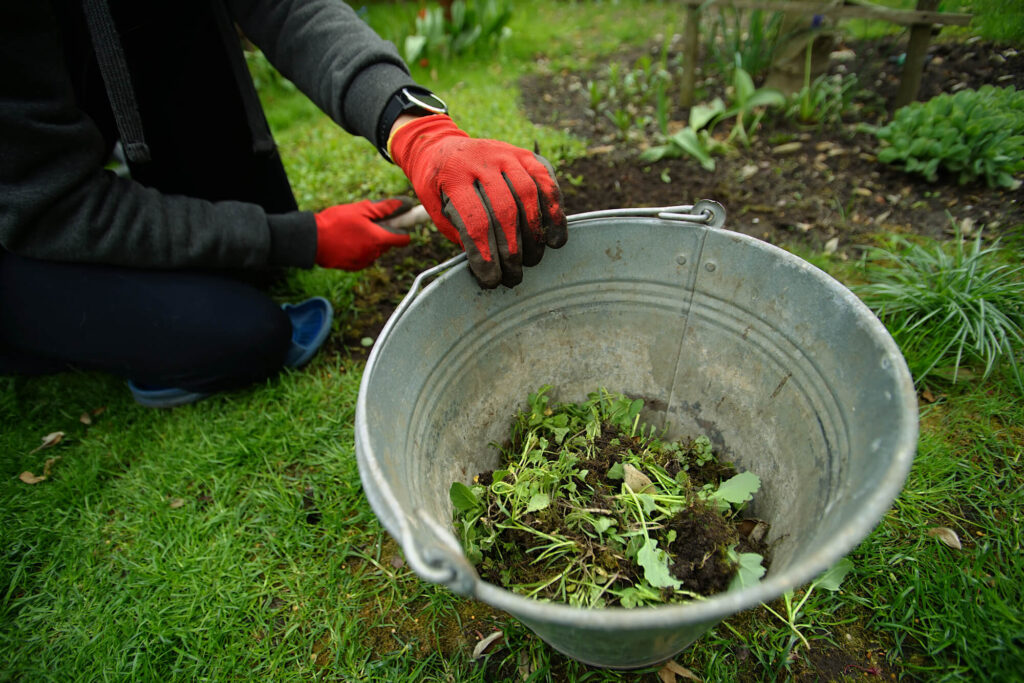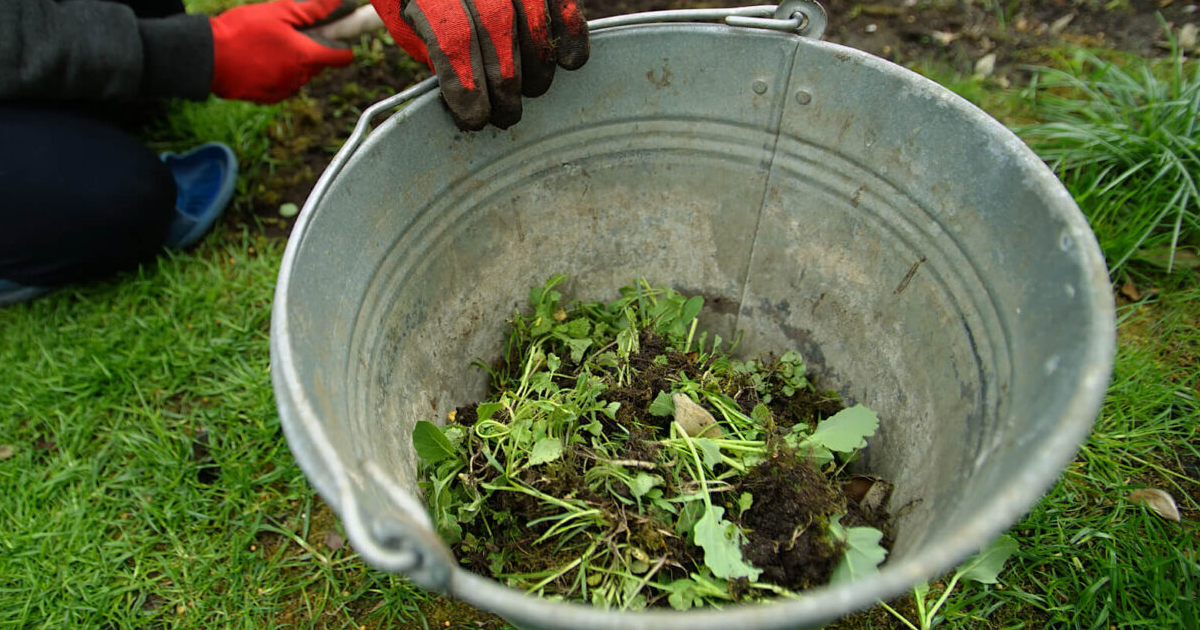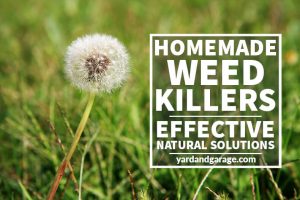
Your yard should be a clean space for you and your family to enjoy and unwind. However, weeds and brush can quickly take over. This can turn your lovely garden into a complete wilderness! It can be pretty daunting at first glance, but it doesn’t have to stay that way.
While many articles talk about getting rid of weeds and brush, not many of them work, leaving homeowners exhausted. This guide talks about the most effective ways to clear a yard full of weeds and brush as quickly as possible with minimal damage to your garden.
Table of Contents
The Most Common Lawn Weeds
We will first look at some of the most common lawn weeds that perpetuate gardens and yards in the USA. These weeds are divided into two categories. They are either troublesome weeds, which means they suck the nutrients from the soil, rendering it infertile for other plants and vegetables, or noxious weeds, which have been touted as injurious to public health and the ecosystem.
1. Crabgrass (Digitaria spp.)
Also known as watergrass, Crabgrass is a troublesome weed that grows in the warm season. You would expect to see it in your yard mid-spring through summer. It germinates during the spring season, when the ground temperature is as warm as 55°F, for at least 4-5 consecutive days.
Crabgrass usually perishes when the temperature becomes cooler, near the onset of the fall season.
Crabgrass is a weak, ground-hugging weed that spreads all over the nearby grass. It creates several hundred seeds during the end of summer, which can then sprout the following year.
A safe, organic way to get rid of Crabgrass is to overseed your yard regularly. This will foster an impenetrable root system, not providing sufficient space for crabgrass seeds to grow. You can also mow your lawn to a height of 3 inches, which will help keep the soil cooler, obstructing the growth of this warm-season weed.
If you spot the presence of Crabgrass, you can simply hand-pull the plants when they are still young to prevent them from setting seeds. If you had Crabgrass growing in your yard previously, rake the lawn to remove any debris and then apply organic corn meal gluten as a pre-emergent herbicide.
2. Dandelion (Taraxacum officinale)
Dandelion is a perennial weed that is commonly found in California. They germinate when the soil is moist with a temperature of around 50°F. The germination process is more rapid when the ground temperature is higher, i.e., close to 77°F.
Light is another factor that can catalyze the germination of dandelions. These seeds usually take 14 to 21 days to germinate.
Lovely yellow flowers accompany dandelions. The dandelion seeds quickly spread and require the thinnest turf to thrive. Dandelion seeds are carried by air and need the slightest opening in the ground to spread.
Since dandelion seeds are airborne and can nestle in the barest of openings in your yard, you should ensure regular overseeding to maintain a dense root system. This will prevent the propagation of this weed. If you already have dandelion weeds, you have limited organic options.
The best way is to dig them up with as much of the root as possible. Alternatively, you can use a biological agent called Sarritor, which attacks dandelions without damaging your grass.
3. Black Medic (Medicago lupulina)
Black Medic is a prostrate broadleaf weed commonly found in yards and gardens of the USA and Southern Canada. Black Medic is characterized as an annual species. It lives only one year but leaves enough seeds to last a few coming years. Black Medic seeds germinate in the spring season and can survive in disturbed soil and dry and sunny areas. They are most abundant along roadsides but can be a real bane in home gardens and yards.
Black Medic belongs to the legume family, which means it can fix its own nitrogen. It can thus survive in soil lacking nutrients. This quality gives it the ability to survive on low-mowed lawns. It is a spreading weed that can reproduce from its seed if left untouched. It creates a long taproot that grows deep into the soil. Several hairy stems then grow out from it.
This weed is not tolerant to shade so you can prevent its growth with a dense canopy. You should ensure constant hand pulling to prevent the reproduction of seeds. Hoeing is often futile unless done regularly. The aim is to dislodge their deep taproot completely to prevent re-growth. You can also use a vinegar-based herbicide to curb the growth of the Black Medic.
4. Purslane (Portulaca oleracea)
Purslane is widespread in the USA, and grows in almost every state. It is also touted as a noxious weed in at least one U.S. state. A single Purslane plant is capable of producing almost 240,000 seeds, which can make it very hard to get rid of. These seeds can germinate 5-40 years later. This annual summer plant most often inhabits low-maintenance gardens.
Purslane can reproduce through its tiny black seeds during the end of spring season and also reproduce through its leaves. You may have hoed this pesky weed one day, and found its full re-growth the very next day.
The Purslane weed can live in the soil for years, so you should destroy it as soon as you spot it. The best organic method is hand-pulling. After pulling the plant out, make sure you completely destroy it to prevent it from reproducing vegetatively. You can also try mulching garden beds to barricade the development of seedlings.
5. Quackgrass (Elytrigia repens)
Quackgrass is a perennial weed that belongs to the grass family. It is considered a B-rated noxious. You will find it throughout California in the yards of homes. Quackgrass seeds germinate during fall or spring. These seeds can reproduce more than just once a year, and these seeds can remain workable for a period of up to 10 years.
It has long rhizomes, usually a straw-color, that create a heavy base in the soil, which can then sprout new shoots. This plant reproduces through its seeds.
If any pieces of this plant are left in the soil, it can quickly re-grow. Therefore, you need to completely dig out this fast-growing grass as soon as you spot it. Make sure you dispose of the waste bin instead of the compost pile, where it may start growing again. Ensure frequent mowing of the lawn to prevent this plant from creating seeds. You can also pour boiling water on Quackgrass to kill this plant. However, you may need to reseed the nearby affected areas.
6. Nutsedge
Nutsedge, commonly known as Nutgrass, is a persistent and fast-growing weed that commonly occurs in homes and yards throughout the USA. It can be pretty challenging to get rid of this invasive weed. They derive their name Nut Grass due to their close resemblance to grass. Nut sedges are often perennial, so they perish in the fall as soon as temperatures start to drop. However, their stems and tubers can still exist in the soil and shoot the following spring season.
They can spread through seeds, rhizomes (underground stems), and their small tubers. A new tuber can emerge just 4-6 weeks after the emergence of a new shoot.
You can eradicate this plant by digging it out by hand. Make sure you excavate the root so that it is not left behind in the soil. You can also moisten the soil and apply a sugar coat as sugar can eat the nutsedge, successfully eradicating it.
7. Creeping Charlie (Glechoma hederacea)
Creeping Charlie, also known as ground ivy, is an aggressively growing perennial weed that can be hard to remove once it sets in a garden. This weed blooms during early spring, i.e., May to April. You can easily recognize it from its tiny, purple-colored flowers and bright green leaves with a scalloped border. The Creeping Charlie prefers to grow in shady yards.
This weed is hard to get rid of due to the way it spreads. It is characterized by creeping stems, often called stolons, that grow along the nearby ground. It also spreads via seeds. This weed will re-grow if even a tiny piece of the root, the rhizome, is left behind in the soil.
You should hard rake your yard regularly and consistently pull out this weed if you want to get rid of it eventually. In case of an infestation, you can use a diluted borax solution to apply to the soil. Make sure you do not repeat this more than once a year, as the boron content in borax can be detrimental to your garden.
Manual Weed Removal Methods
Even if it is not noxious, weed can compete with your plants for nutrients, leaving them dry. Weeds can also lead to many plant diseases, which can harm you and your garden. While prevention is crucial to weed management, often, the growth of weeds gets unnoticed. In such an event, you need effective weed removal methods to ensure your yard is safe and pleasant for you to use.
1. Mowing and Cutting
Mowing and cutting are effective ways to hamper the growth of weeds, especially before the weeds bloom. However, this method is only effective for certain species of weeds. Others can re-grow even after the plant has been cut. You can regularly mow and cut your yard as a complementary treatment to the use of herbicide to limit further growth of weeds.
It is imperative that you properly discard the cut and mowed parts of the weed to prevent it from re-sprouting from the root or stem. You should chuck these well away from your pasture or yard. Mowing and cutting will not only ensure a well-maintained yard but also prevent weed seeds from multiplying and growing.
2. Weedeating
Weedeating uses a trimmer to cut grass and vegetation that you cannot reach with a lawnmower. Edging is a common weed eating technique that not only gives the lawn a manicured appearance but also ensures weed removal from tight spaces.
Several weeds collect at the edges of a garden. Over time, they can seep into your fertile soil and take over your entire yard. Therefore, you should make sure you trim around your garden, along the fence lines, and around the posts where weeds might start to grow and ultimately penetrate your lawn.
3. Weed pulling
Weed pulling is an effective spot treatment to get rid of herbaceous weeds. You can try hand pulling. However, if you’re hesitant to do so, you can use tools like weed wrenches and hoes. Weed wrenches are more practical for eradicating larger shrubs, and hand pulling and hoeing are more effective for a smaller or an initial stage weed infestation.
Hand pulling is a highly effective method to limit and remove several perennial weeds. Hand pulling has a relatively limited ecological impact and does not damage neighboring plants or your garden.
You should pull out the weeds rather slowly and carefully to not disrupt the surrounding soil. Disrupted soil can become a breeding ground for specific weeds. Make sure you have the necessary protective gear like gloves if you decide to hand pull, as weeds can cause skin irritation.
4. Aeration of Lawn
At times, the dirt under the plants tends to get compacted. When this happens, plants can stress out, and this gives weed an opportunity to set in. Aerating your lawn can help prevent this, providing the grass a chance to compete with weeds. To decipher if your lawn needs aeration, dig into your soil (approximately a foot deep). If the roots don’t extend beyond 2 inches, this is a sign that you need to aerate your lawn.
In order to aerate your lawn, you should water your yard two days prior. You can buy or rent an aerator and run it over the garden. Finish this by applying a layer of sand over the aerated garden.
5. Mulching
You can mulch your garden beds and around trees to block the growth of weeds. You can use mulch like cardboard, grass cuttings, shredded leaves, wood chippings, or straw to coat the soil surrounding the plants in your garden. This mulch helps block the sunlight, preventing weed seeds from germinating.
It is advised that you use organic mulch. However, you can use inorganic mulch as well. Make sure the mulch coating is a few inches from the plant base to prevent rotting and insect incursions. The idea is to block the food source of the weed, preventing its growth and survival.
6. Organic/Natural Weed Killing Methods
You can use organic solutions to kill weeds in your yard. Bear in mind that some of these may be more effective on some weeds than others.
Vinegar:
Vinegar contains acetic acid, which can kill weeds. Make sure you mix vinegar with a mild dishwasher, so it sticks to the weeds. Vinegar can dehydrate plants, so it is best to apply it to weeds found on pavements and sidewalks, away from your other plants. If you use it near other plants, spray it on the weeds to ensure minimal damage to nearby vegetation. You will see results in just 30 minutes. However, this is not a permanent solution, and weeds may grow back some days later.
Boiling Water:
You can also use boiling water to kill weeds. However, the water should be poured exclusively on weeds as it can kill other plants and vegetation. You may use a kettle with a spout for spot treatment so that the heat and water do not penetrate other plants.
Flame Weeding:
Flame weeding uses intense heat to kill weeds. You can use a propane gas burner to direct carefully controlled heat towards the weeds and not the surrounding plants. This will damage the plant’s cell structure, preventing it from growing. Be careful so as not to burn the vegetation. Flame weeding is most effective on smaller weeds/seedlings.
Clearing Weeds with Chemicals
Some weeds require more aggressive treatment. You can use chemicals to get rid of these pesky weeds and acquire a weed-free garden again. Of course, chemicals do have side effects for your yard, but they are sometimes required as weeds can do more harm than the chemicals themselves.
1. Weed and Feed
Weed and feed is the universal term for several lawn chemicals. The weed component in the weed and feed consists of herbicides, which can kill some leafy weeds. The ‘feed’ in weed and feed refers to fertilizer that helps the yard flourish. This combination helps your yard get rid of weeds, promoting its nutritional health simultaneously.
Weed and feed, when applied to the garden, kills the weed but does not harm the grass unless you apply too much of it. This chemical is available in both granular and liquid forms.
2. Pre-Emergent Herbicides
Pre-Emergent Herbicide is a chemical that hampers the growth of weed seedlings into their established form. They are highly effective for some weed species like Crabgrass. They should be applied to the weed seeds during their germination process.
The application of pre-emergent Herbicide should be when the soil is warm, up to 50-55 degrees, for it to be effective. You should choose a pre-emergent herbicide based on the weeds it can kill. This way, you can make sure your yard is weed-free. Pre-emergent herbicides can damage new lawns, so don’t use them until the grass sets for a few months.
3. Brush killer
As the name suggests, Brush killer can kill hard-to-get-rid-of brushes in yards. Most brush killers contain chemicals like Triclopyr, Fluazifop, and 2,4-D that effectively kill weeds. Brush killers can kill the most invasive brushwood species.
Herbicides can kill plants, so make sure you know how (and how much) to use them. You should study the extent of the invasion before selecting the suitable brush killer herbicide.
Other Tips for Keeping Your Yard Weed Free
Prevention is always better than cure! There are some effective tips all homeowners can use to limit the growth and spread of weeds in their yard. Let’s take a look.
1. Fertilize Your Lawn
Fertilizers can replace any lost nutrients in your yard. This helps foster healthy plants and ensures strong grassroots that provide no space for weeds to set in and reproduce. You should regularly fertilize your garden to hamper weeds from taking a foothold in any bare patches.
2. Reseeding Bare Spots
Lawn repair is essential if you want to prevent weeds from setting in. If you spot any bare spots on your lawn, plant grass seed there, or else it will allow weed to set in. This will also boost the overall aesthetics of your yard!
3. Mow the Grass Regularly
Mowing grass regularly is not just for the lawn’s aesthetic. It can also prevent weed growth. Experts recommend that you regularly mow the grass to a length of 3.5 to 4 inches, as grass at this height can compete with weeds and choke it out.
Frequently Asked Questions
1. Can I Use Pre-Emergent Herbicide if Weeds are Already Present?
Pre-emergent herbicide is only effective if used before weeds are already present in your garden. It prevents seeds from completing the germination process. It should ideally be applied to your yard during early spring before weeds emerge. You may use post-emergent herbicide to kill weeds already visible above the ground.
2. How can I clear my yard full of weeds using natural methods?
You can use the following natural, organic methods to get rid of weeds:
- Use mulch like newspaper or shredded leaves to cover the soil. This blocks sunlight and oxygen from reaching the weed and letting it grow or survive.
- Use natural solutions like vinegar and boiling water on weeds to kill them.
- Hand pull the weeds out and dispose of them far away to prevent a re-growth in your yard.
3. How do you kill weeds without killing grass?
You can avoid chemicals to kill weeds. Apply natural solutions like vinegar and boiling water and apply directly on the weed, making sure it doesn’t fall on the surrounding grass. Use spot treatment and pull out weeds individually using your hand or a hoe.
4. What is the best way to remove weeds from a large area?
You can choose to dig up the weeds manually using a garden hoe and then apply a herbicide to the large area. If you don’t want chemicals, you can also use a large quantity of diluted vinegar to spray on the affected area.
Conclusion
Weeds can be detrimental to your garden. Therefore, you should try to get rid of them as soon as possible. Weeds can quickly spread, and then they can be hard to control.
You can use natural solutions like vinegar, boiling water, and flame weeding to kill weeds or use chemicals for larger, more invasive weed infestations.
With these methods, you will soon be able to enjoy a weed-free yard with minimal damage suffered by the rest of your plants.



